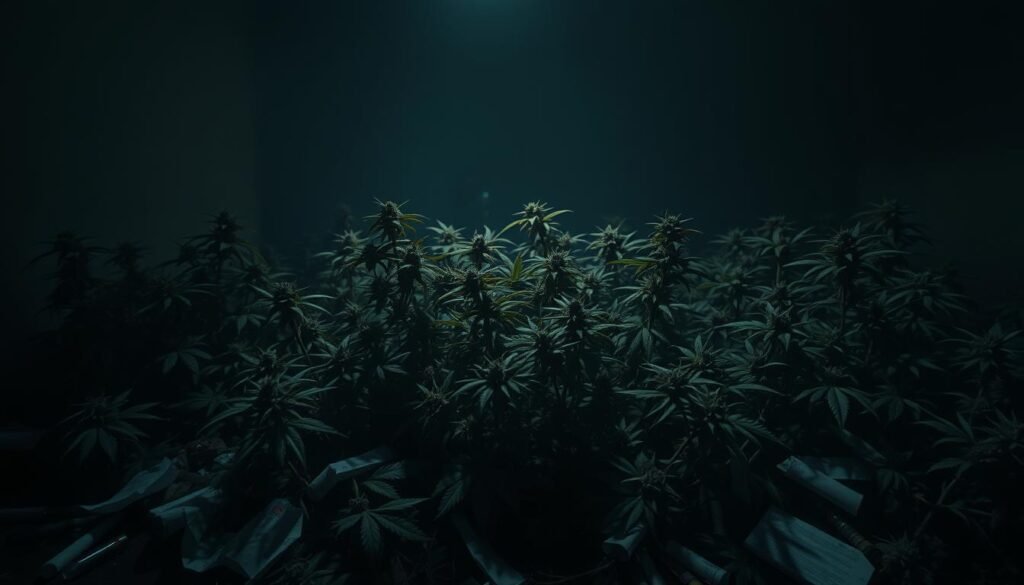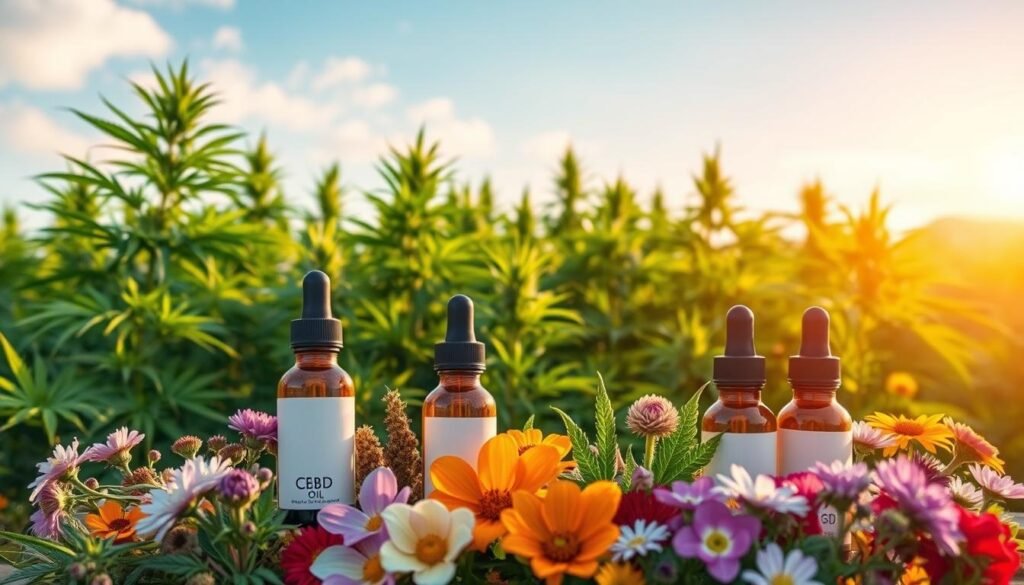Marijuana is the most commonly used illegal substance in the U.S., according to the CDC. In 2020, over 49 million people aged 12 or older used marijuana in the past year. As more states legalize marijuana, its use is increasing.
New information is emerging about marijuana addiction and cannabis withdrawal. This article explores what happens when you lose THC, the psychoactive compound in cannabis. We’ll discuss how it affects your body, including tolerance breaks and withdrawal symptoms.
Table of Contents
ToggleKey Takeaways
- The average THC content in seized cannabis has risen from 4% in 1995 to 17% in 2017, with some products reaching up to 90% THC.
- Nearly one-third of regular cannabis users may develop problematic use patterns, leading to addiction and withdrawal symptoms.
- Cannabis use is associated with increased risks of mental health issues, such as schizophrenia, bipolar disorder, depression, and anxiety.
- The CBD market is expected to grow rapidly, providing an alternative for those seeking the benefits of cannabis without the psychoactive effects.
- Responsible cannabis consumption and understanding the legal landscape are important for users to navigate the evolving marijuana landscape.
The Pothead’s Dilemma: Losing Possessions
Losing personal items is a common problem for marijuana users. Many struggle to find their keys, wallets, or important documents. This forgetfulness is a typical side effect of cannabis use.
The Reality of Misplacing Objects as a Marijuana User
Cannabis users often can’t remember where they put their phone or wallet. THC, the main compound in marijuana, can impair memory and focus. This makes it hard to keep track of everyday items.
The effects of marijuana often lead to misplaced belongings. This causes frustration and inconvenience for many users.
Personal Experiences and Anecdotes of Losing Things While High
Sarah, a cannabis user, often loses her possessions while high. She’s found her car keys in strange places like the fridge or bathroom cabinet. Sarah’s story shows the challenges of staying organized while using cannabis.
Alex once lost his wallet at a party with friends who were also high. He spent the night searching, hoping it would turn up. No one could remember where he had put it.
These stories highlight the impact of drug tolerance on keeping track of belongings. Many marijuana users struggle with this issue as they deal with the plant’s effects.
| Occurrence Rate of Marijuana Use | Duration and Age of Marijuana Use | Comparison of Views on Marijuana Usage |
|---|---|---|
| Frequent at infrequent parties, occasional at home visits, and occasionally alone or with friends. | Integral part of life since young teenage years; started by older brother; currently 33 years old. | Boyfriend sees it as ceremonial, ethically acceptable akin to having a beer after work; girlfriend views it as an escapist mentality, prefers not to be around it. |
“It’s so easy to get distracted and forget where I put things when I’m high.”
Understanding Marijuana Withdrawal Symptoms
Quitting cannabis can lead to withdrawal symptoms for regular users. Studies show that cannabis withdrawal syndrome affects about 47% of those trying to quit or cut back. This impacts nearly half of all users.
Recognizing the Signs of Cannabis Withdrawal
Withdrawal symptoms can start 24-72 hours after last use, especially for heavy users. These may include irritability, nervousness, and sleep problems. Other signs are weight loss, decreased appetite, and restlessness.
Physical symptoms like tremors, sweating, headaches, and chills may occur. Nausea and stomach pain are also common during withdrawal.
The marijuana withdrawal timeline follows a specific pattern. In the first three days, initial symptoms appear with potential relapse. During the first week to 10 days, symptoms peak.
Physical symptoms start to fade, but psychological effects like depression may intensify. After 10-20 days, most symptoms subside, and individuals begin to feel stable.
Heavy users may experience withdrawal for about three weeks. It can take up to three months for the body to fully excrete cannabinoids. Doctors may prescribe anti-anxiety medications to help with severe symptoms.
Various therapies can aid in recovery from marijuana addiction. These include cognitive behavioral therapy (CBT) and dialectical behavior therapy (DBT). Holistic approaches like equine therapy, art therapy, and yoga can also support long-term recovery.
“In 2020, over 49 million people in the U.S. aged 12 or older reported using marijuana within the past year.”
The Marijuana Withdrawal Timeline
Quitting cannabis can be tough. Knowing what to expect helps. Symptoms usually start 1-3 days after stopping use.
The first week is often the hardest. Depression and irritability may worsen. Up to 95.5% of regular users report at least one withdrawal symptom when quitting.
Daily smokers tend to face more symptoms. Physical discomfort like vomiting and sweating begins to ease in the second week.
| Withdrawal Timeline | Symptoms |
|---|---|
| Days 1-3 | Onset of withdrawal symptoms, including vomiting, stomach pain, and excessive sweating |
| Week 1-2 | Psychological effects, such as depression and irritability, intensify |
| Week 2-3 | Physical discomfort starts to subside, but continued treatment is important |
Withdrawal can last up to three weeks. Ongoing support is key. Many factors affect withdrawal severity and length.
These include cannabis potency, use frequency, and mental health. Users of potent marijuana (20%-80% THC) may face stronger symptoms than those using 2%-6% THC.
Professional help boosts recovery success. Understanding the timeline helps manage challenges. Preparation is crucial for a smoother transition.
Lost THC: Coping with Decreased Potency
Cannabis users may face challenges when their THC supply decreases. The potency and effects they’re used to can change significantly. This shift can be tough as the body adjusts to lower THC levels.
The Impact of Decreased THC Levels on the User Experience
Reduced THC levels can lead to various changes in the user’s experience. These changes affect both short-term and long-term aspects of cannabis use.
- Decreased intensity of psychoactive effects, such as altered perception, mood, and cognitive function
- Increased difficulty in recognizing and processing human emotions, particularly negative expressions like anger
- Disruptions in sleep patterns, appetite, and executive function
- Residual and long-term changes in brain activity that can affect emotional behavior and overall well-being
| Metric | Impact of Decreased THC Levels |
|---|---|
| Psychoactive Effects | Reduced intensity of altered perception, mood, and cognitive function |
| Emotional Processing | Increased difficulty in recognizing and responding to human emotions, especially negative expressions |
| Physiological Changes | Disruptions in sleep patterns, appetite, and executive function |
| Brain Activity | Residual and long-term changes in brain activity affecting emotional behavior and overall well-being |
Coping with these changes can be tough for regular cannabis users. They must adapt to a new reality without familiar effects. Understanding these impacts is crucial for developing effective coping strategies.
Endocannabinoid System and Drug Tolerance
Regular cannabis use leads to THC tolerance. This is linked to the endocannabinoid system. This system regulates various body functions through receptors and neurotransmitters.
Repeated THC exposure desensitizes CB1 receptors in the nervous system. Over time, the body needs more THC for the same effects. This is called drug tolerance.
THC affects pain relief, catalepsy, and body temperature more than anandamide (AEA). AEA is a natural endocannabinoid. Ongoing THC use reduces CB1 receptor activity in the brain and spinal cord.
AEA-treated mice with a specific gene deletion show less CB1 receptor changes. This suggests tolerance depends on the substance’s activity. Understanding this process could help develop new addiction treatments.
- Studies have found that THC administration results in greater rightward shifts in THC dose-effect curves for antinociception (pain relief), catalepsy, and hypothermia compared to anandamide (AEA), a naturally occurring endocannabinoid.
- Subchronic THC exposure significantly attenuates agonist-stimulated [35S]GTPγS binding in the brain and spinal cord, and reduces [3H]WIN55,212-2 binding in the brain, indicating reduced CB1 receptor activity.
- Interestingly, AEA-treated FAAH-/- mice (mice with a genetic deletion of the enzyme that breaks down AEA) show less CB1 receptor downregulation and desensitization than THC-treated mice, suggesting that tolerance expression is more affected by the ligand’s intrinsic activity.
“Repeated administration of Δ9-tetrahydrocannabinol (THC) induces tolerance that correlates with desensitization and downregulation of CB1 cannabinoid receptors in the CNS.”
Marijuana Addiction and Seeking Help
Marijuana use is rising, especially among young people. Many see it as harmless, but some users can develop addiction. Cannabis dependence is becoming a pressing issue for many.
Signs of Cannabis Dependence and Addiction
Cannabis dependence and addiction have several signs:
- Continued use despite negative consequences, such as problems at work, school, or in personal relationships
- Inability to cut down or control marijuana use
- Experiencing withdrawal symptoms, such as irritability, anxiety, and sleep disturbances, when trying to quit
- Spending a significant amount of time obtaining, using, or recovering from the effects of marijuana
- Neglecting important activities and responsibilities in favor of marijuana use
Treatment Options and Resources for Marijuana Addiction
Several treatment options exist for those battling marijuana addiction:
- Medical Detox: This may help manage physical and psychological symptoms of cannabis withdrawal.
- Cognitive-Behavioral Therapy (CBT): CBT can help change thought patterns and behaviors linked to marijuana use.
- Holistic Therapies: Mindfulness, yoga, and exercise can help manage emotional aspects of addiction.
Resources for marijuana addiction help include:
- Addiction treatment centers and programs
- Support groups, such as Marijuana Anonymous
- Online resources and hotlines
- Consulting with a mental health professional or addiction specialist

Recognizing cannabis dependence signs is crucial. Seeking proper treatment helps overcome marijuana addiction. With help, individuals can regain control of their lives.
The Legal Landscape of Marijuana
The legal landscape of marijuana is rapidly changing across the United States. 29 states now have medical marijuana laws. 8 of these states also allow recreational use.
This creates complex implications for cannabis users. The legal environment is evolving quickly. Users need to stay informed about these changes.
State-by-State Legalization and Implications
State laws on marijuana create a confusing legal environment. Some states fully legalize medical and recreational use. Others maintain strict prohibitions.
This leads to challenges for marijuana consumers. They may face prosecution when crossing state lines. Laws can differ greatly between states.
This shifting legal landscape underscores the importance for cannabis users to stay informed about the laws in their respective states and to exercise caution when traveling with or consuming the drug.
Marijuana remains federally illegal, creating a complex regulatory environment. More states are legalizing marijuana for medical and recreational use. The legal landscape will continue to change.
Cannabis users must stay alert to these changes. They need to navigate the evolving legal terrain carefully. Staying informed is crucial for compliance.
CBD Benefits and Alternatives
CBD offers a potential alternative for those without access to THC-rich cannabis. It’s a non-psychoactive compound from the cannabis plant with potential therapeutic properties.
Unlike THC, CBD doesn’t produce a “high” feeling. It shows promise for managing pain, reducing inflammation, and easing epilepsy symptoms. CBD may also help with anxiety and depression.
CBD’s legal status is a key advantage. Hemp-derived CBD with less than 0.3% THC is federally legal. This makes it more accessible than THC-rich cannabis.
However, caution is needed when choosing CBD products. The market lacks regulation. A study found synthetic cannabinoids in some CBD vaping liquids.
Vaping CBD has been linked to lung and heart problems. Some cases of irreversible lung damage, called “popcorn lung,” have been reported.
Research thoroughly before using CBD as an alternative. Consult healthcare professionals and choose high-quality products from trusted sources. This approach can help you find a safe alternative to your usual cannabis supply.

“CBD has shown promise in managing chronic pain, reducing inflammation, alleviating symptoms of epilepsy and seizures, and addressing anxiety and depression.”
Responsible Cannabis Consumption
Responsible cannabis use is vital as marijuana becomes more available. Enjoy marijuana’s effects safely by using caution and moderation. This approach can help avoid cannabis withdrawal symptoms and THC detox concerns.
Tips for Moderation and Safe Use
Consider these tips for a positive and responsible cannabis experience:
- Start with low doses and gradually increase until you find your optimal level. Avoid overconsumption, which can lead to unpleasant side effects.
- Be mindful of your setting and surroundings. Consume cannabis in a safe, comfortable, and controlled environment.
- Educate yourself on the potential marijuana effects and be aware of any personal sensitivities or health conditions that could be affected by cannabis use.
- Recognize the signs of dependence, such as difficulty controlling your use or experiencing withdrawal symptoms when you stop. Seek help if needed.
- Combine cannabis use with healthy lifestyle choices, such as proper nutrition, exercise, and stress management, to enhance your overall well-being.
A responsible approach to cannabis consumption maximizes benefits and minimizes risks. Moderation and mindfulness are key to a safe, positive experience.
Enjoy marijuana responsibly by staying aware of its effects on you. Your well-being should always come first when using cannabis.
The Future of Marijuana Legalization
The marijuana legalization landscape is changing rapidly. Public support for cannabis is growing. The path to wider access and acceptance is becoming clearer, but debates persist.
Two-thirds of Americans now support marijuana legalization. Incarceration rates for marijuana offenses have decreased. However, racial disparities in policing and arrests remain a concern.
Marijuana legalization impacts more than personal use. Legal medical marijuana may increase opioid deaths. Experts worry about heavy cannabis use causing schizophrenia in young men.
States face complex decisions as they legalize cannabis. Taxation and regulation will shape the industry’s future. Colorado’s marijuana tax data offers valuable insights for policymakers.
Health professionals must balance potential benefits and risks. Responsible and fair implementation of marijuana legalization is crucial.
“The future of marijuana legalization is a delicate balance between progress and caution, as we strive to harness the potential of this dynamic industry while mitigating its potential harms.”
The way forward requires a thoughtful, evidence-based approach. We must learn from early adopters of marijuana legalization. Stakeholders need to work together to shape a responsible future.
This future should prioritize public health and social justice. It should also promote responsible industry growth.
Conclusion
We’ve examined the challenges of THC loss in cannabis. This article covered decreased potency, withdrawal symptoms, and the impact on marijuana users. We’ve provided insights into the realities faced when THC supply is disrupted.
We explored the endocannabinoid system and drug tolerance implications. This information helps maintain a healthy relationship with cannabis. We also discussed marijuana addiction and treatment options to help readers seek appropriate support.
The legal landscape of marijuana varies by state. Understanding these differences is crucial as the cannabis industry grows. We also looked at CBD benefits and responsible consumption practices.
This guide equips readers with knowledge about lost thc, marijuana effects, and cannabis withdrawal. It also covers thc detox, drug tolerance, and the endocannabinoid system. Understanding marijuana addiction, cbd benefits, cannabis potency, and marijuana legalization is important. This knowledge helps maintain an informed relationship with cannabis, despite potential challenges.
FAQ
What happens when you lose access to THC, the primary psychoactive compound in cannabis?
Losing THC access can change the cannabis experience. Users may feel less potent effects. The body adjusts to functioning without usual THC levels.
What are the typical marijuana withdrawal symptoms and timeline?
Marijuana withdrawal symptoms start 24-72 hours after last use. These include irritability, nervousness, and sleep problems. Physical symptoms like tremors and headaches may occur.
The body expels the drug within 30 days. Most people experience withdrawal effects for about three weeks.
How does the endocannabinoid system relate to drug tolerance?
Regular cannabis use builds tolerance to THC effects. Users may need higher doses for desired results. Loss of THC potency can significantly impact the user’s experience.
What are the signs of cannabis dependence and addiction, and what treatment options are available?
Cannabis dependence signs include continued use despite negative consequences. Treatment options include medical detox and cognitive-behavioral therapy. Holistic therapies and addiction resources are also available.
How does the legal landscape of marijuana vary across the United States?
Marijuana laws differ across states. Some allow medical and recreational use. Regulations and legal consequences vary significantly between states.
How can CBD (cannabidiol) be used as an alternative or complement to traditional marijuana use?
CBD has been studied for its therapeutic properties. It may serve as an alternative to THC-rich cannabis. Some individuals use it to complement traditional marijuana use.
What are some tips for responsible cannabis consumption?
Mindful dosage and setting help ensure safe cannabis use. Be aware of potential side effects. Recognize dependence signs and seek help when needed.


